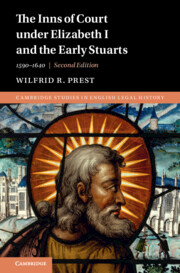Book contents
- The Inns of Court under Elizabeth I and the Early Stuarts
- Cambridge Studies in English Legal History
- The Inns of Court under Elizabeth I and the Early Stuarts
- Copyright page
- Contents
- Figures and Tables
- Preface to the First Edition
- Acknowledgements
- Abbreviations
- Introduction to the Second Edition
- 1 Dimensions
- 2 The Quality of Membership
- 3 Ranks of Membership
- 4 Administration and Government
- 5 Discipline and Disorder
- 6 Learning the Law
- 7 Legal and Liberal Education
- 8 Papists
- 9 Preachers, Puritans and the Religion of Lawyers
- 10 The Inns of Court and the English Revolution
- Book part
- Glossary
- Note: Archives and Manuscripts at the Inns of Court
- Index
5 - Discipline and Disorder
Published online by Cambridge University Press: 15 January 2023
- The Inns of Court under Elizabeth I and the Early Stuarts
- Cambridge Studies in English Legal History
- The Inns of Court under Elizabeth I and the Early Stuarts
- Copyright page
- Contents
- Figures and Tables
- Preface to the First Edition
- Acknowledgements
- Abbreviations
- Introduction to the Second Edition
- 1 Dimensions
- 2 The Quality of Membership
- 3 Ranks of Membership
- 4 Administration and Government
- 5 Discipline and Disorder
- 6 Learning the Law
- 7 Legal and Liberal Education
- 8 Papists
- 9 Preachers, Puritans and the Religion of Lawyers
- 10 The Inns of Court and the English Revolution
- Book part
- Glossary
- Note: Archives and Manuscripts at the Inns of Court
- Index
Summary
The first section of this chapter, ‘The Scope of Discipline’ traces the fashion in which the benchers initially sought to impose disciplinary constraints on members’ behaviour and demeanour. The growth of the inns after 1550 made it increasingly difficult to police the personal lives of junior members. But the benchers became more anxious to maintain and enhance their own authority, establishing sumptuary regulations on apparel, long hair and beards which emphasised the subordinate status of those below the bench, and sharply escalating measures against casual interpersonal violence within the societies.
They seem to have had some success in eliminating armed assaults, if not other forms of physical violence, while traditional violent behaviour outside the walls of the inns appears to have waned towards the end of our period.However, as ‘The Range of Defiance’ illustrates, collective defiance of and disobedience to the bench became a feature of life from the 1610s onwards, with sporadic outbreaks continuing until the end of the century and beyond, over sumptuary regulations, gambling at Christmas commons, and other issues.
The final section, ‘Authority and Revolt’ proposes that outbreaks of protest and rebellion in the latter half of our period were closely related to the major institutional changes examined in the preceding chapters.
Keywords
- Type
- Chapter
- Information
- The Inns of Court under Elizabeth I and the Early Stuarts1590–1640, pp. 123 - 150Publisher: Cambridge University PressPrint publication year: 2023

